您好,登录后才能下订单哦!
1 定义一个函数(构造器)对象,使用this定义属性
2 使用new 和构造器创建一个新对象
当使用new关键字后,其函数的调用将不再是函数,而是一个原型,就以这个原型为模板,构造出自己的实例,然后进行对应的个性化操作,将其当做构造器来处理其特殊的属性或方法。
//古老的定义对象的方式
var obj= {
a:'abc',
b:'123',
c:'[1,2,3,4]',
}
console.log(obj.a,obj.b,obj.c)
function fn(x){
this.x=x;
}
console.log(typeof(fn)) // 此处返回是一个函数
function fn1(x,y) {
this.x=x;
this.y=y;
console.log(this) //指代函数本身,而不是实例化后的结果
console.log(arguments)
}
a=new fn1(10,20) //对象构建,fn1由普通函数变成了一个构造器,new 先做对象,基于原型将a进行处理,通过对象亏帮属性
console.log(a.x,a.y)结果如下

function fn(x,y) {
console.log('fn')
this.x=x; //初始化属性
this.y=y;
this.show=()=> ('show') //初始化方法,及函数
}
//继承
function fn1(x,y,z) {
console.log('fn1')
fn.call(this,x,y); //调用父类构造器,
this.z=z;
}
a=new fn1(1,2,3)
console.log('fn1',a) //此处将a修改成一个对象,及字典,其对象中包含着所有的属性和方法
console.log(a.show(),a.x,a.y,a.z)结果如下

1 类的定义使用class 关键字,创建的本质还是函数,是一个特殊的函数
2 一个类只能拥有一个名为constructor的构造方法,如果没有显示的定义一个构造方法,则会默认添加一个constructor方法
3 继承使用extends 关键字
4 一个构造器可以使用super关键字来调用父类的构造函数
5 类没有私有属性
class fn{ //定义类
constructor(x,y){
console.log('fn')
this.x=x; //定义属性
this.y=y;
}
show () //定义方法
{
console.log(this,this.x,this.y)
}
}
//继承关系
class fn1 extends fn{ //使用extends表示继承
constructor(x,y,z){
console.log('fn1')
super(x,y); //调用父类方法,必须传入对应的值,否则父类无入值则会报错。
this.z=z;
}
}
a=new fn1(1,2,3)
console.log(a.show()) //调用父类的方法
console.log(a.x,a.y,a.z)结果如下

函数重载及函数名称相同,参数个数或类型不同,此处称为重载
子类汇总直接可以重写父类的方法,如果需要使用父类的方法,则使用super.method()的方式调用
class fn{ //定义类
constructor(x,y){
console.log('fn')
this.x=x; //定义属性
this.y=y;
}
show () //定义方法
{
console.log(this,this.x,this.y)
}
}
class fn1 extends fn{ //使用extends表示继承
constructor(x,y,z){
console.log('fn1')
super(x,y); //调用父类方法,必须传入对应的值,否则父类无入值则会报错。
this.z=z;
}
show(){ //属性重载操作
console.log(this,this.x,this.y,this.z)
}
}
a=new fn1(1,2,3)
console.log(a.show()) //重载后的属性调用
console.log(a.x,a.y,a.z)结果如下

使用箭头函数重写方法
class fn{ //定义类
constructor(x,y){
console.log('fn')
this.x=x; //定义属性
this.y=y;
}
show = () => console.log(this,this.x,this.y)
}
class fn1 extends fn{ //使用extends表示继承
constructor(x,y,z){
console.log('fn1')
super(x,y); //调用父类方法,必须传入对应的值,否则父类无入值则会报错。
this.z=z;
}
show = () => console.log(this,this.x,this.y,this.z)
}
a=new fn1(1,2,3)
console.log(a.show()) //重载后的属性调用
console.log(a.x,a.y,a.z)class fn{ //定义类
constructor(x,y){
this.x=x; //定义属性
this.y=y;
this.show=() => console.log('this fn',this.x,this.y)
}
show = () => console.log('fn',this.x,this.y)
}
class fn1 extends fn{ //使用extends表示继承
constructor(x,y,z){
super(x,y); //调用父类方法,必须传入对应的值,否则父类无入值则会报错。
this.z=z;
this.show=() => console.log('this fn1',this.x,this.y,this.z);
}
show = () => console.log('fn1',this.x,this.y,this.z);
}
a=new fn1(1,2,3)
console.log(a.show()) 结果如下

此处默认调用的是子类的属性,
class fn{ //定义类
constructor(x,y){
this.x=x; //定义属性
this.y=y;
this.show=() => console.log('this fn',this.x,this.y)
}
show = () => console.log('fn',this.x,this.y)
}
class fn1 extends fn{ //使用extends表示继承
constructor(x,y,z){
super(x,y); //调用父类方法,必须传入对应的值,否则父类无入值则会报错。
this.z=z;
// this.show=() => console.log('this fn1',this.x,this.y,this.z);
}
show = () => console.log('fn1',this.x,this.y,this.z);
}
a=new fn1(1,2,3)
console.log(a.show()) 结果如下

此处调用的是子类的方法
class fn{ //定义类
constructor(x,y){
this.x=x; //定义属性
this.y=y;
this.show=() => console.log('this fn',this.x,this.y)
}
show = () => console.log('fn',this.x,this.y)
}
class fn1 extends fn{ //使用extends表示继承
constructor(x,y,z){
super(x,y); //调用父类方法,必须传入对应的值,否则父类无入值则会报错。
this.z=z;
// this.show=() => console.log('this fn1',this.x,this.y,this.z);
}
// show = () => console.log('fn1',this.x,this.y,this.z);
}
a=new fn1(1,2,3)
console.log(a.show()) 结果如下

class fn{ //定义类
constructor(x,y){
this.x=x; //定义属性
this.y=y;
// this.show=() => console.log('this fn',this.x,this.y)
}
show = () => console.log('fn',this.x,this.y)
}
class fn1 extends fn{ //使用extends表示继承
constructor(x,y,z){
super(x,y); //调用父类方法,必须传入对应的值,否则父类无入值则会报错。
this.z=z;
// this.show=() => console.log('this fn1',this.x,this.y,this.z);
}
// show = () => console.log('fn1',this.x,this.y,this.z);
}
a=new fn1(1,2,3)
console.log(a.show()) 结果如下

总结
属性和方法定义,不管是父类还是子类。都是优先使用属性,若两个都是方法,则子类覆盖父类 ,如果都是属性,则是子类覆盖父类,子类的优先级是高于父类的
静态属性目前支持不完全
在方法前面加上static就是静态方法了,此处的静态方法是在类中进行调用的,而不是在实例中。
class fn{ //定义类
constructor(x,y){
this.x=x; //定义属性
this.y=y;
}
static show = () => console.log('fn',this.x,this.y)
}
console.log(fn.show())
a=new fn(1,2)
console.log(a.show())结果如下
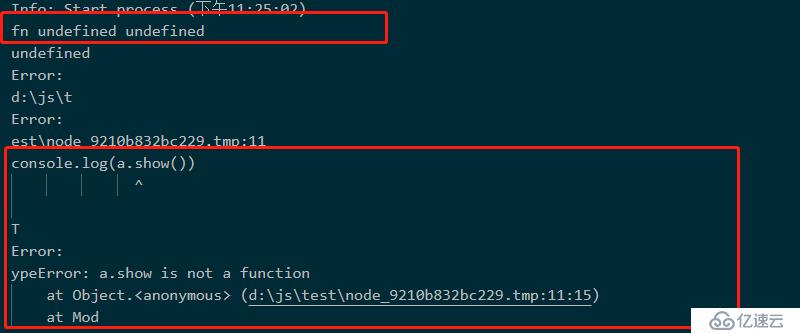
虽然JavaScript和C和Java都有this,但JavaScript的表现是不同的
原因在于C,Java是静态编译语言,this是在编译期间绑定的,而js是动态语言,是在运行期间锁定的。
var school= { //此处定义一个对象,其中包含name和getNamefunc两个,其中name是属性,getNamefunc是方法,其返回值是一个函数
name: 'test',
getNamefunc: function(){
console.log(this.name)
console.log(this)
console.log('-----------------')
return function() {
console.log(this == global); //检查其是否是全局的
return this.name;
}
}
}
method=school.getNamefunc //此属性调用后返回的是函数的类型,并未调用外层函数
a=method() //调用外层函数
a() //调用内层函数结果如下
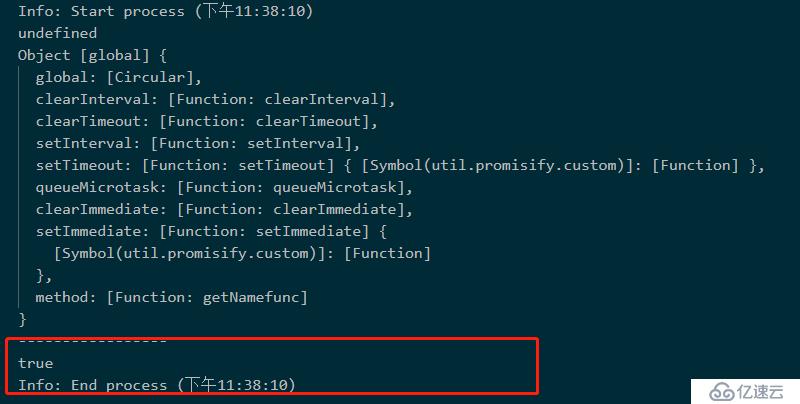
上面的返回结果是其this本应该是school,却被处理称为了全局函数
var school= { //此处定义一个对象,其中包含name和getNamefunc两个,其中name是属性,getNamefunc是方法,其返回值是一个函数
name: 'test',
getNamefunc: function(){
console.log(this.name)
console.log(this)
console.log('-----------------')
return function() {
console.log(this == global); //检查其是否是全局的
return this.name;
}
}
}
method=school.getNamefunc() //此处调用外层函数
a=method() //调用外层函数结果如下

此处的结果是this仍然是全局属性
分析上例
第三行的打印结果是true,则表明当前是global的作用于,因为调用这个返回的函数是直接调用的,这是一个普通函数调用,因此this是全局对象第四行undefined,就是因为this是global,所以没name属性
这就是函数调用的时候,调用方式不同,this对应的对象不同,它已经不是C++,Java的指向实例本身了。
this的问题,这是历史遗留问题,新版本只能兼容了。
var school= { //此处定义一个对象,其中包含name和getNamefunc两个,其中name是属性,getNamefunc是方法,其返回值是一个函数
name: 'test',
getNamefunc: function(){
console.log(this.name)
console.log(this)
console.log('-----------------')
return function(that) { //通过此处传递参数的方式改变
console.log(that == global); //检查其是否是全局的
return that.name;
}
}
}
console.log(school.getNamefunc()(school))结果如下

通过call将指定的this进行指定了。JavaScript中指代的是这个,其他的Java指定的不同,普通函数的调用和对象的调用是不同的,普通函数的调用中的thi指代的是全局变量,而在对象中调用,默认传递的值是this的本身
var school= { //此处定义一个对象,其中包含name和getNamefunc两个,其中name是属性,getNamefunc是方法,其返回值是一个函数
name: 'test',
getNamefunc: function(){
console.log(this.name)
console.log(this)
console.log('-----------------')
return function() {
console.log(this == global); //检查其是否是全局的
return this.name;
}
}
}
var school1={
'name': 'test1'
}
method=school.getNamefunc() //此属性调用后返回的是函数的类型,并未调用外层函数
console.log(method.call(school1)) //通过call将其this传递进去,
console.log('---------------')
console.log(method.call(school))
console.log('++++++++++++++++')
console.log(method.apply(school)) //通过apply,将其this传递过去结果如下
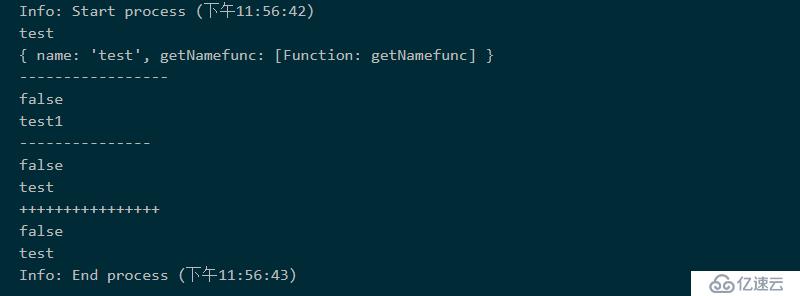
相关源码
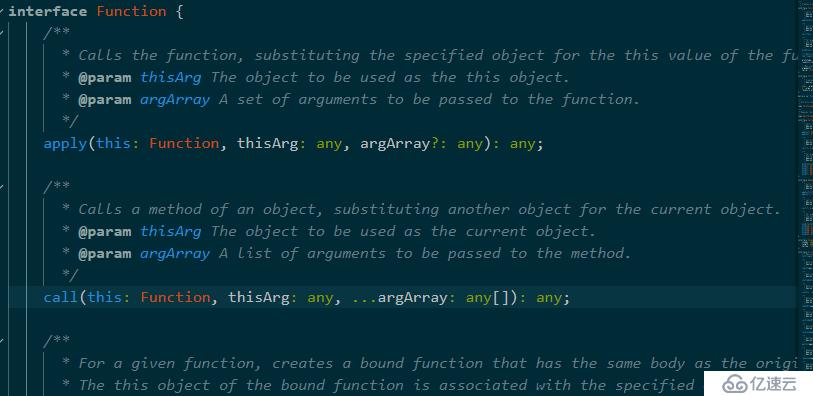
apply和 call方法都是函数对象的方法
apply传递其他参数使用数组,call传递其他参数需要使用可变参数收集。相关情况如下
var school= { //此处定义一个对象,其中包含name和getNamefunc两个,其中name是属性,getNamefunc是方法,其返回值是一个函数
name: 'test',
getNamefunc: function(){
console.log(this.name)
console.log(this)
console.log('-----------------')
return function(x,y,z) {
console.log(this == global,x,y,z); //检查其是否是全局的
return this.name;
}
}
}
method=school.getNamefunc() //此属性调用后返回的是函数的类型,并未调用外层函数
console.log('---------------')
console.log(method.call(school,[1,2,3])) //此处传地过去不会解构,是一个参数
console.log('++++++++++++++++')
console.log(method.apply(school,[1,2,3])) //通过apply,会解构,结果如下

var school= { //此处定义一个对象,其中包含name和getNamefunc两个,其中name是属性,getNamefunc是方法,其返回值是一个函数
name: 'test',
getNamefunc: function(){
console.log(this.name)
console.log(this)
console.log('-----------------')
return function(x,y,z) {
console.log(this == global,x,y,z); //检查其是否是全局的
return this.name;
}
}
}
method=school.getNamefunc() //此属性调用后返回的是函数的类型,并未调用外层函数
console.log(method.bind(school)(1,2,3))结果如下

bind 是会返回一个新函数,其和偏函数相似
var school= { //此处定义一个对象,其中包含name和getNamefunc两个,其中name是属性,getNamefunc是方法,其返回值是一个函数
name: 'test',
getNamefunc: function(){
console.log(this.name)
console.log(this)
console.log('-----------------')
return (x,y,z) => {
console.log(this == global,x,y,z); //检查其是否是全局的
return this.name;
}
}
}
school1={
name:'test1'
}
method=school.getNamefunc() //此属性调用后返回的是函数的类型,并未调用外层函数
console.log(method(1,2,3))结果如下

最外层使用箭头函数的结果
var school= { //此处定义一个对象,其中包含name和getNamefunc两个,其中name是属性,getNamefunc是方法,其返回值是一个函数
name: 'test',
getNamefunc: () => {
console.log(this.name)
console.log(this)
console.log('-----------------')
return (x,y,z) => {
console.log(this == global,x,y,z); //检查其是否是全局的
return this.name;
}
}
}
school1={
name:'test1'
}
method=school.getNamefunc() //此属性调用后返回的是函数的类型,并未调用外层函数
console.log(method(1,2,3))结果如下

因此,一般不建议最外层使用箭头函数
Mixin 模式,及混合模式,这是一种不用继承就能复用的技术,主要还是为了解决多重继承的问题,多重继承路径是个问题
JS是基于对象的,类和对象都是对象模板
混合Mixin,指的是将一个对象的全部或者部分拷贝到另一个对象上去了,其实就是属性,可以将多个类或者对象混合成一个类或者对象,任何一个对象都可以作为另一个对象的原型。
class test{
constructor(){
console.log('test',this)
if (typeof(this.show) !=='function') {
throw new ReferenceError('should define stringify.');
}
}
}
class test1 extends test{
constructor(x,y){
super();
this.x=x;
this.y=y;
}
show(){
return `test1 ${this.x} ${this.y}`;
}
}
p=new test1(1,2)
console.log(p.show())结果如下

此处的核心是谁调用的问题,上述父类的this是子类的实例,而不是子类调用父类后父类形成的实例,因此这也是验证通过的原因。
class test{
constructor(){
console.log('test',this)
if (typeof(this.show) !=='function') {
throw new ReferenceError('should define stringify.');
}
}
}
class test1 extends test{
constructor(x,y){
super();
this.x=x;
this.y=y;
}
show(){
return `test1 ${this.x} ${this.y}`;
}
}
class test2 extends test1 {
constructor(x,y,z) {
super(x,y);
this.z=z;
}
}
p=new test2(1,2)
console.log(p.show()) //此处自己本身没有show,则通过调用父类的show来实现,上述传入的this 仍然是子类的实例,结果如下

通过在test中使用函数并传递参数的方式将test1的相关属性注入进去,相关代码如下
初步改造结果如下
class test1{
constructor(x,y){
this.x=x;
this.y=y;
}
show(){
return `test1 ${this.x} ${this.y}`;
}
}
const test = function test(SUP) { //此函数的返回值是一个类,通过将类test1传入其中进行相关的操作处理并进行输出
return class extends SUP {
constructor(...args) {
super(...args);
console.log('test',this)
if (typeof(this.show) !=='function') {
throw new ReferenceError('should define stringify.');
}
}
}
}
class test2 extends test(test1){
constructor(x,y,z) {
super(x,y);
this.z=z;
}
}
p=new test2(1,2,3)
console.log(p.show())结果如下

将上述函数修改为箭头函数结果如下
class test1{
constructor(x,y){
this.x=x;
this.y=y;
}
show(){
return `test1 ${this.x} ${this.y}`;
}
}
const test = SUP=> class extends SUP {
constructor(...args) {
super(...args);
console.log('test',this)
if (typeof(this.show) !=='function') {
throw new ReferenceError('should define stringify.');
}
}
}
class test2 extends test(test1){
constructor(x,y,z) {
super(x,y);
this.z=z;
}
}
p=new test2(1,2,3)
console.log(p.show())注意:
test(test1)这一步实际上是一个匿名箭头函数的调用,返回一个新的类型,test2继承自这个新的类型,增强了功能,react大量使用了这种Mixin技术。
try {
throw 1; // 抛出异常
} catch (error){ //此处不用指定异常类型,此处的error是上面的throw扔出来的
console.log(error,typeof(error));
}
抛出一个对象
try {
throw {}; // 抛出异常
} catch (error){ //此处不用指定异常类型,此处的error是上面的throw扔出来的
console.log(error,typeof(error));
}结果如下

抛出一个函数
try {
throw () => console.log(2); // 抛出异常
} catch (error){ //此处不用指定异常类型,此处的error是上面的throw扔出来的
console.log(error,typeof(error));
}结果如下

try {
throw Error('new Error'); // 抛出异常
} catch (error){ //此处不用指定异常类型,此处的error是上面的throw扔出来的
console.log(error,typeof(error));
}结果如下

try {
throw ReferenceError('new Error')
} catch (error){ //此处不用指定类型 ,此处的error是接上面扔出来的东西
console.log(error,typeof(error));
};
结果如下

try {
throw ReferenceError('new Error')
} catch (error){ //此处不用指定类型 ,此处的error是接上面扔出来的东西
console.log(error,typeof(error)); //此处不影响下面的执行
console.log(error.constructor); //此处的执行结果是函数
};结果如下

try {
throw ReferenceError('new Error')
} catch (error){ //此处不用指定类型 ,此处的error是接上面扔出来的东西
console.log(error,typeof(error)); //此处不影响下面的执行
console.log(error.constructor.name); //获取函数名称
};结果如下

try {
throw null;
} catch (error){ //此处不用指定类型 ,此处的error是接上面扔出来的东西
console.log(error,typeof(error));
console.log(error.constructor.name); //一切皆函数
} finally { //定义必须执行的函数
console.log('1325345234')
}结果如下
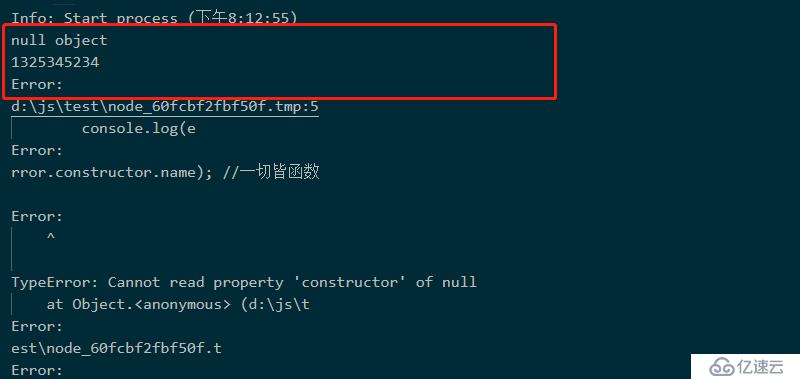
常量的声明和初始化时不能被分开的,常量只是对象的地址不能发生改变了,并不是其中的内容也不能改变了。
const l1=[1,2,3,4]
l1.pop() //l1虽然是一个常量,但其可以被修改
console.log(l1)
完全解构
const l1=[1,2,3,4]
const [a,b,c,d]=l1
console.log(a,b,c,d)
丢弃解构
const l1=[1,2,3,4]
const [a,b,,c,d]=l1
console.log(a,b,c,d)结果如下

const l1=[1,2,3,4]
const [a]=l1
console.log(a)结果如下

可变变量
const l1=[1,2,3,4]
const [a,...d]=l1
console.log(a,d)结果如下

const l1=[1,2,3,4]
const [a,...d,e]=l1 //可变长必须放置在最后面
console.log(a,d,e)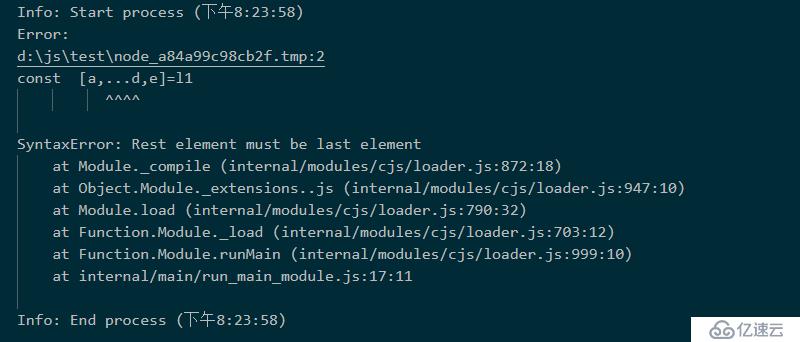
默认值
const l1=[1,2,3,4]
const [x=10,,,,y=20]=l1 //能覆盖的覆盖,不能覆盖的保持原值,先赋值,再覆盖,
console.log(x,y) 
const arr = [1,[2,3],4]; //三个元素,嵌套解构
const [a,[b,c],d]=arr;
console.log(a,b,c,d); //直接拆开
const [e,f]=arr; // 只有两
console.log(e,f); // 第一个和第二个
const [g,h,i,j=18]=arr; // 三个 加1 ,则是对应的
console.log(g,h,i,j);
const [k,...l]=arr; // 此处会将后面两个元素进行搬家
console.log(k,l);结果如下

| 方法 | 描述 |
|---|---|
| push(...items) | 尾部追多个元素 |
| pop() | 移除最后一个元素,并返回它 |
| map | 引入处理函数来处理数组中的每一个元素,返回新的数组 |
| filter | 引入处理函数处理数组中的每一个元素,此处理函数返回true的元素保留,否则该元素被过滤掉,保留的元素构成新的数组返回 |
| foreach | 迭代所有元素,无返回值 |
const l1=[1,2,3,4]
l1.push([5,6,7,8])
l1.push(...['a','b','c'])
l1.push(9,10,11)
console.log(l1)结果如下

const l1=[1,2,3,4]
l1.push([5,6,7,8])
l1.push(...['a','b','c'])
l1.push(9,10,11)
console.log(l1.pop())
console.log(l1.pop())
console.log(l1.pop())
console.log(l1)结果如下

const abs = (x) => x**2
const l1=[1,2,3,4]
console.log(l1.map(abs))结果如下

const abs = function (x) {
if (x%2==0) {
return true;
}
else {
return false;
}
}
const l1=[1,2,3,4]
console.log(l1.filter(abs))结果如下

const l1=[1,2,3,4]
const newarr= l1.forEach(x=>x+10) //无返回值
console.log(newarr,l1)结果如下

有一个数组const arr=[1,2,3,4,5];,要求计算出所有元素平方值是偶数且大于10的。
代码一
const arr=[1,2,3,4,5];
console.log(arr.filter(x => ((x**2)%2==0 && (x**2)>10)))代码二,若平方是偶数,则该数也应该是偶数,则如下
const arr=[1,2,3,4,5];
console.log(arr.filter((x=> x%2==0 && x**2>10)))代码三,通过map来实现
const arr=[1,2,3,4,5];
console.log(Math.log2(((arr.filter(x=>x%2==0)).map(x=>x**2)).filter(x=>x>10)))代码四,求10的平方根,然后再进行相关比较
const arr=[1,2,3,4,5];
const cond=10
const cond1=Math.sqrt(cond)
console.log(arr.filter(x=>x%2==0 && x> cond1))var metadata= {
title: "Seratchpad",
translations :[
{
locale: "de",
localization_tags: [],
last_edit: "2019-01-01T08:11:11",
url: "/de/docs/Tools/scratchpad",
title: "JavaScript-Umgebung"
}
],
url: "/en-US/docs/Tools/Scratchpad"
}
var {title:enTitle,translations:[{title: localeTitle}] }=metadata; //: 后面的是重命名
console.log(enTitle)
console.log(localeTitle)
| object 的静态方法 | 描述 |
|---|---|
| object.keys(obj) | ES5开始支持,返回所有key |
| object.values(obj) | 返回所有值,实验阶段,支持较差 |
| object.entries(obj) | 返回所有值,试验阶段,支持较差 |
| object.assign(target,...sources) | 使用多个source对象,来填充target对象,返回target对象 |
var obj = {
a:100,
b:200,
c:()=>{}
}
console.log(Object.keys(obj)) //返回所有的键
console.log(Object.values(obj)) //返回所有的值
console.log(Object.entries(obj))//返回所有的键和值
obj1={
d:300,
e:400,
}
let obj2=Object.assign(obj,obj1) //返回新的对象
console.log()结果如下

ES6 之前,JS没有出现模块化系统
JS主要是在前端浏览器中使用,JS文件下载缓存到客户端,在浏览器中执行。
比如简单的表达本地验证,漂浮一个广告。
服务器端使用ASP,JSP等动态网页技术,将动态生成数据嵌入一个HTNL模板,里面夹杂着JS后使用<script>标签,返回浏览器端。
这时候的JS知识一些简单的函数和语句组合。
2005年后,随着Google大量使用了AJAX技术后,可以一步请求服务器端数据,带来了前端交互的巨大变化,前端的功能需求越来越多,代码也越来越多,随着JS文件的增加,灾难性的后果产生了,由于习惯了随便写,JS脚本中各种全局变量污染,函数名冲突,无法表达脚本之间的依赖关系。此时便有待模块化的产生。
2008年V8引擎发布后,2009年诞生了nodejs,支持服务端JS编程,但没有模块化是不可以的,之后产生了commonjs规范。
commonjs 规范
使用全局require函数来导入模块,模块名就是文件名,使用exports导出变量
exports包含了所有需要导出的函数require会将exports中的所有函数遍历出来即可进行相关的处理操作。
AMD规范
AMD (asynchronous module definition)异步模块定义,使用异步方式加载模块,模块的加载不影响它后面语句的执行,所有依这个模块的语句,都需要定义在一个回调函数中,回调函数中使用模块的变量和函数,等模块加载完成之后,这回调函数才执行,就可以安全的使用模块中的资源了。其实现就是AMD/requireJS.AMD虽然是异步,但是会预先加载和执行。
CMD(Common Module Defintion),使用seajs,作者是淘宝前端玉伯,兼容并解决了requirejs的问题,CMD推崇as lazy as possible,尽可能的懒加载。
import语句,导入另一个模块导出的绑定
export语句,从模块中导出函数,对象,值等,供其他模块import导入
创建两个文件
1.js和2.js
1.js中写入如下数据
//导出默认类
export default class A {//此处设置默认导出,可以导出类,函数,变量和常量
constructor(x){
this.x=x;
}
show() {
console.log(this.x)
}
}
//导出函数
export var foo =() =>console.log('foo function')
//导出变量
export const CONST='aaa';
2.js中进行相关导入
如下
import {foo,CONST} from './1'; //此处若不指定./当前目录。则默认是全局变量
import A from "./1";
let a=new A(10);
a.show();
foo();
console.log(CONST)
由于相关的引擎均不支持import 和export操作,因此需要通过相关的附加模块来实现此种操作
上述中使用{}可以同时导入多个环境变量。
转译就是从一种语言代码到另一个语言代码,当然可以使从高版本转译到低版本的支持语句。
由于JS存在不同的版本,不同浏览器的兼容问题可通过transpiler转译工具进行解决,而babel就是其中的一种,官网如下
https://www.babeljs.cn
1 需要生成package.json文件,用于编译使用,可通过npm init 进行初始化
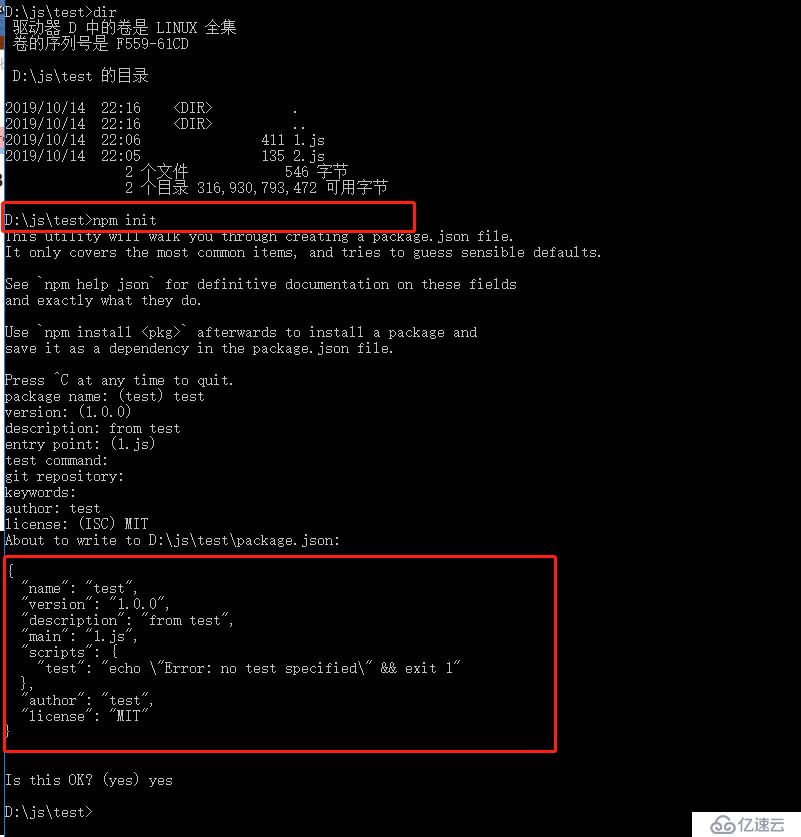
生成文件如下

.npmrc文件,此文件可通过touch .npmrc创建
可以放置到npm目录下的npmrc文件中。也可以放置到用户家目录中,也可以放置到项目根目录中,此处放置到项目根目录,如下
registry=http://registry.npm.taobao.org如下 
npm install babel-core babel-cli --save-dev
相关参数说明
--save-dev 说明
当你为你的模块安装一个依赖模块时,正常情况下你得先安装他们(在模块根目录下npm install mode-name),然后连同版本号手动将其添加到模块配置文件package.json中的依赖中
--save 和--save-dev可以省略你手动修改package.json文件的步骤。
npm install mode-name --save 自动将模块和版本号添加到dependencies部分,用于在打包至线上的依赖关系时使用
npm install mode-name --save-dev 自动将模块和版本号添加到devdependencise部分查看package.json中的内容
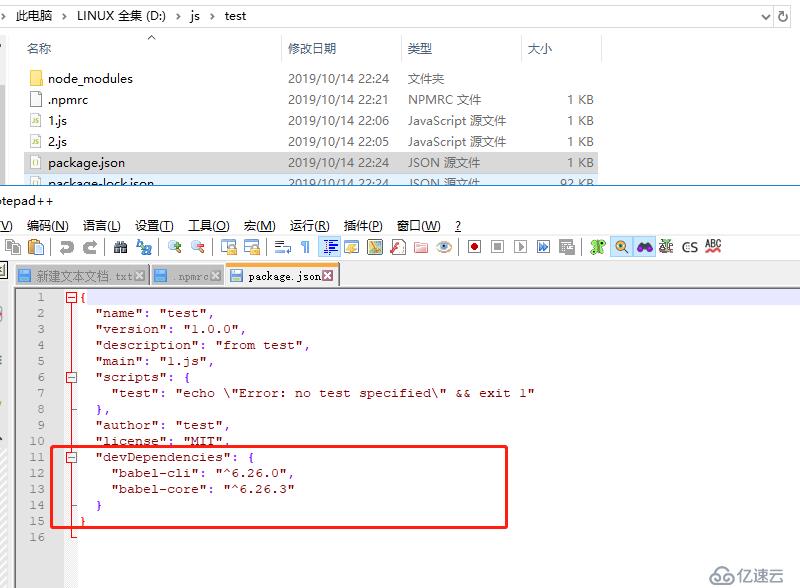
项目根目录中创建src和lib目录
src是源码目录;
lib是目标目录;

在目录根目录下创建.babelrc文件,json格式,其babelrc是和babel运行相关的
内容如下
{
"presets":["env"]
}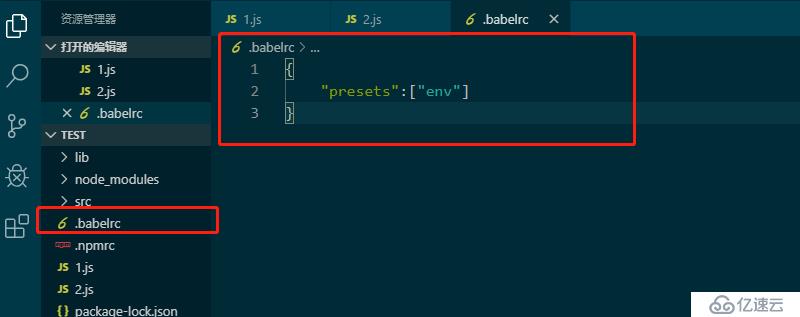
{
"name": "test",
"version": "1.0.0",
"description": "from test",
"main": "1.js",
"scripts": {
"build": "babel src -d lib"
},
"author": "test",
"license": "MIT",
"devDependencies": {
"babel-cli": "^6.26.0",
"babel-core": "^6.26.3"
}
}此处是scripts中的修改,其若目标为目录,则为-d,若目标为文件,则为-o。
将1.js 和 2.js放置到src下
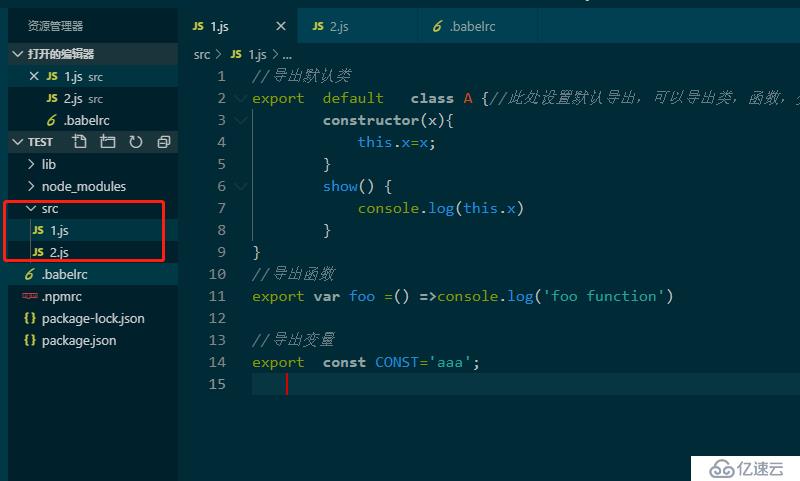
npm install babel-preset-env --save-dev
npm run build 

转换后的结果
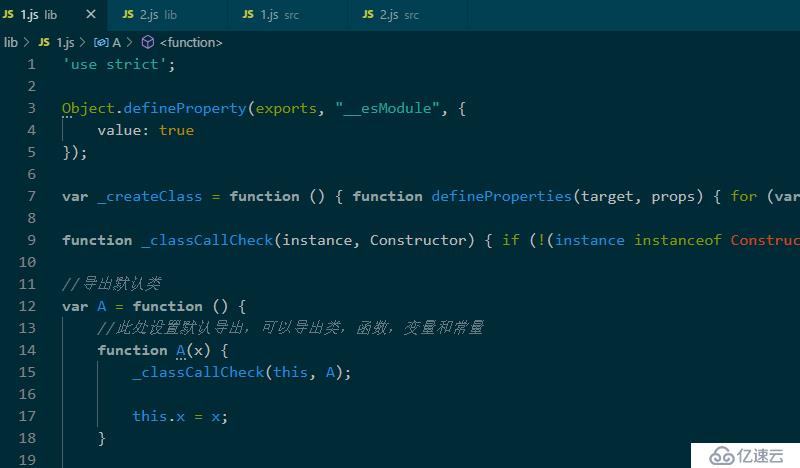

运行如下

后期的通过webpack来实现所有的的联动,自动化的打包操作全部进行处理。
免责声明:本站发布的内容(图片、视频和文字)以原创、转载和分享为主,文章观点不代表本网站立场,如果涉及侵权请联系站长邮箱:is@yisu.com进行举报,并提供相关证据,一经查实,将立刻删除涉嫌侵权内容。